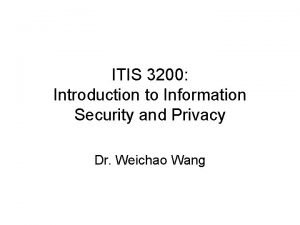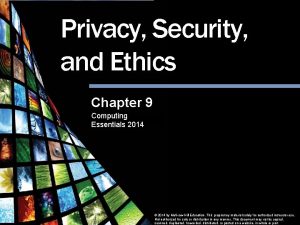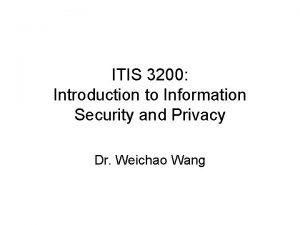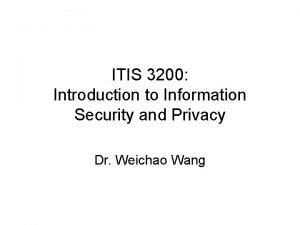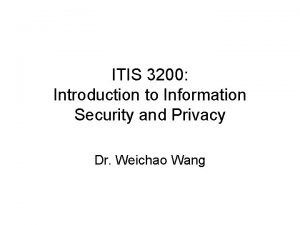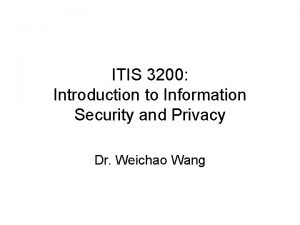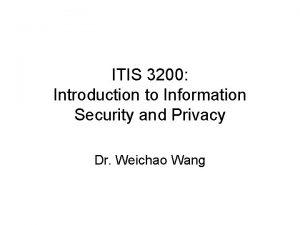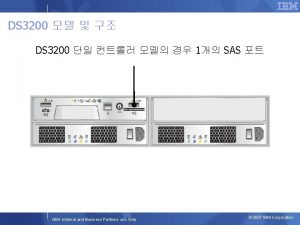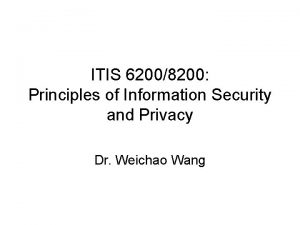ITIS 3200 Introduction to Information Security and Privacy














- Slides: 14

ITIS 3200: Introduction to Information Security and Privacy Dr. Weichao Wang

Syllabus • See handout – Homework will usually have 4 -5 questions and due in one week. It is due at the time that the class begins. – Late homework, term paper, and project • Within 24 hours: 50% of full score • After that: 0% – Project/term paper • Individual effort – Conduct some hands-on experiments – Or choose a security problem and write a survey paper – A reference question list will be provided – Midterm and final exam – Misc: eating, drinking, and cell phone (text & twitter)

Before class • Are you really surprised when you learn the government is collecting our communication records? • Several interesting questions – Two companies each has some private data. They need to jointly calculate some result without disclosing their information. • Secure multiparty computation • Is this solution useful? – Zero knowledge proof: • Can I prove to you that I know a secret without telling you anything? (practically) – Car key remote jammer

• Compromise of user privacy – Key logger through your typing sounds – Copy of your physical key – Recovery of voices through a bag of snack

Perfect Storm of Social Networks • By March 2014, Facebook has 1. 28 Billion active users each month. Twitter has 500 Million tweets per day. • Human activities explain only 40% of the Internet traffic, the other 60%: Bots – Bingbots and Googlebots explain a big portion of the traffic


Examples in real life • Attack on Twitter – Hack into the victim’s email account – DDo. S to paralyze Twitter, facebook, etc • Data mining attacks on public database – My. Edu. com – Groupon, Google Offer, and Amazon Local – Worm attack on smart grid – Use social network to detect disease breakout – Remotely control insulin pump of a patient

Security overview • Risks – Why there are risks • Adversaries – Smart and dedicated – Many of them, considering the high unemployment rate – Hiding in the dark – From fun to profit (worm self-changing botnet target at specific systems)

Security overview • Physical security is not enough (can you be sure that your physical security methods are sound and enough? Example in Las Vegas, supply chain attacks, ATM machine, hotel doors)

Security overview • What can go wrong – Trojan horse: USB keys – Corrupted internal worker – Vulnerabilities of protocols or security mechanisms (security patch has problems too) – By-passing protection walls – Backdoors for systems (Linux password) – Known attacks ignored (push and poll)

Information security • Encryption – You can read the information only when you know the key • Authentication – You are who you claim you are • Authorization – The role and the right

Information security • Information integrity – The data has never been changed or changed in an inappropriate way • Non-repudiation – Cannot deny your words (digital cash example) • Privacy – Who should know, how much, how to use the information • Your cell phone or medical records • RFID • Traffic cameras in Minnesota

Security overview • Defending methods – Prevention • • Prevent (password, salt, private salt, searching) Deter: raising the bar (password guessing, login slow) Deflect: making other target more attractive Diversify – Detection • • Monitoring (who, what, and how) Intrusion detection (signature based, anomaly based) IP telephony track Authenticity of the evidence (digital media)

Security Overview • Recovery – Recover data (check point) – Identify the damage – Forensics – Confinement • Tolerance – Maintain a decent service quality – Automatically degrade video quality while reserving bandwidth for voice
 Itis 3200
Itis 3200 Privacy awareness and hipaa privacy training cvs
Privacy awareness and hipaa privacy training cvs Microsoft from back doors gov active
Microsoft from back doors gov active Chapter 9 privacy security and ethics
Chapter 9 privacy security and ethics Chapter 9 privacy security and ethics
Chapter 9 privacy security and ethics Chapter 9 privacy security and ethics
Chapter 9 privacy security and ethics Hipaa privacy and security awareness training
Hipaa privacy and security awareness training Destructive event or prank a virus was created to deliver
Destructive event or prank a virus was created to deliver Private security
Private security Visa international security model diagram
Visa international security model diagram Explain about cnss security model
Explain about cnss security model Berat bayi yang baru lahir rata rata 3200 gram
Berat bayi yang baru lahir rata rata 3200 gram Gvc video conference
Gvc video conference System-storage-manager
System-storage-manager Fuji 3200
Fuji 3200
